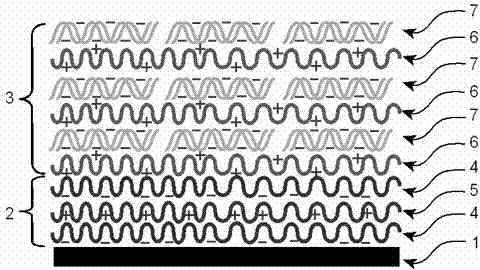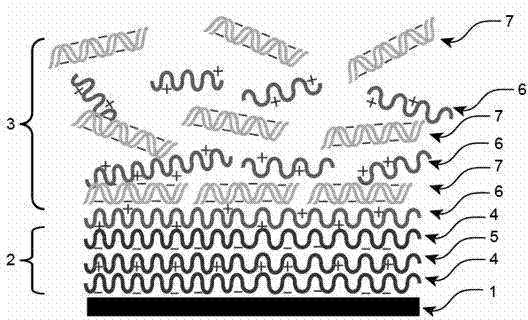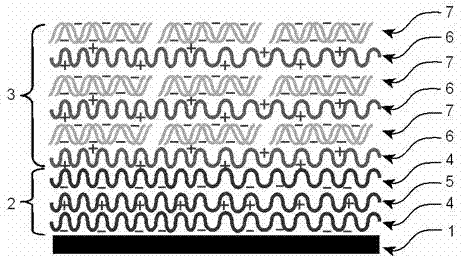Gene-releasing type stent and preparation method thereof
A gene and substrate technology, applied in the field of gene-releasing stents and its preparation, can solve the problems of low drug loading, small loading, and complicated preparation process, and achieve good controllability, rapid release, and simple operation
- Summary
- Abstract
- Description
- Claims
- Application Information
AI Technical Summary
Problems solved by technology
Method used
Image
Examples
Embodiment 1
[0036] Such as figure 1 , 2As shown, the present invention consists of a bare metal stent 1, a substrate layer 2 and a gene-carrying coating 3, and the substrate layer 2 consists of 2 layers of substrate polyanion carrier layer 4 (polyacrylic acid layer) and 1 layer of substrate polycation carrier Layer 5 (polyethyleneimine layer) is composed alternately. The gene-carrying coating 3 is composed of 3 layers of biodegradable polycation carrier 6 (polyurethane) and 3 layers of gene layer 7 (plasmid DNA layer) alternately. Electrostatic attraction is combined with each other.
[0037] The preparation method comprises the following steps:
[0038] (1) Preparation of polyacrylic acid solution: dissolve polyacrylic acid in sodium chloride solution, and the concentration of polyacrylic acid in the prepared solution is 2 mg / mL;
[0039] (2) Preparation of polyethyleneimine solution: dissolve polyethyleneimine in sodium chloride solution, and the concentration of polyethyleneimine in...
Embodiment 2
[0047] Such as figure 1 , 2 As shown, the present invention consists of a bare metal stent 1, a substrate layer 2 and a gene-carrying coating 3, and the substrate layer 2 consists of 16 layers of substrate polyanion carrier layer 4 (polystyrene sulfonic acid layer) and 15 layers of substrate The polycationic carrier layer 5 (polyethyleneimine layer) is composed alternately, and the gene-carrying coating layer 3 is composed of 20 biodegradable polycationic carrier layers 6 (polyurethane) and 20 gene layers 7 alternately, and the above layers are separated by static electricity. The attraction is combined with each other, the gene layer is composed of genes and gene complexes, and the gene complexes are composed of genes (DNA) and polycationic lipids.
[0048] The preparation method comprises the following steps:
[0049] (1) Preparation of polystyrene sulfonic acid solution: dissolve polystyrene sulfonic acid in sodium chloride solution, and the concentration of polystyrene s...
Embodiment 3
[0058] Such as figure 1 , 2 As shown, the present invention consists of a bare metal stent 1, a substrate layer 2 and a gene-carrying coating 3, and the substrate layer 2 consists of a substrate polyanion carrier layer 4 (a mixed layer of polyacrylamide and polyvinyl phosphoric acid) and 1 layer of substrate polycationic carrier layer 5 (mixed layer of chitin and polyarginine) is composed alternately, and the gene-carrying coating layer 3 is composed of 1 layer of biodegradable polycationic carrier layer 6 (polyphosphoramide) and 1 layer of gene Layer 7 is composed alternately, and the above layers are combined with each other by electrostatic attraction. The gene layer is composed of genes and gene complexes. The gene complex is composed of genes (SiRNA), polyvinylamine and polyvinylpyridine.
[0059] The preparation method comprises the following steps:
[0060] (1) Preparation of a mixed solution of polyacrylamide and polyvinyl phosphoric acid: dissolve polyacrylamide and...
PUM
| Property | Measurement | Unit |
|---|---|---|
| Concentration | aaaaa | aaaaa |
| Concentration | aaaaa | aaaaa |
| Concentration | aaaaa | aaaaa |
Abstract
Description
Claims
Application Information
 Login to View More
Login to View More - R&D
- Intellectual Property
- Life Sciences
- Materials
- Tech Scout
- Unparalleled Data Quality
- Higher Quality Content
- 60% Fewer Hallucinations
Browse by: Latest US Patents, China's latest patents, Technical Efficacy Thesaurus, Application Domain, Technology Topic, Popular Technical Reports.
© 2025 PatSnap. All rights reserved.Legal|Privacy policy|Modern Slavery Act Transparency Statement|Sitemap|About US| Contact US: help@patsnap.com



